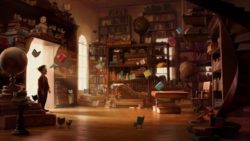William Joyce
Widely know as a prolific and imaginatively versatile children's book writer and illustrator, Shreveport native William Joyce was named one of the "Top 100 people to watch in the new millennium" by Newsweek magazine.

Courtesy of Moonbot Studios.
This scene from Shreveport native William Joyce's animated short film "The Fantastic Flying Books of Mr. Morris Lessmore is titled "Morris Enters the Library."
Shreveport native William Joyce came to widespread attention when he won the 2012 Academy Award for the animated short film The Fantastic Flying Books of Mr. Morris Lessmore, but he has been pleasing audiences with his art since childhood. Joyce was born on December 11, 1957. As a preschooler, he was impressed by Maurice Sendak’s work and began making his own drawings by the time he was in elementary school. He went on to draw cartoons for Shreveport’s Byrd High School’s student newspaper. When his post-high school art teachers tried to change his painting style, he decided to major in film at Southern Methodist University in Dallas, Texas. He graduated with a bachelor of fine arts degree in 1981, and this training in both painting and film formed the basis for his storytelling in a wide range of media: picture books, chapter books, television, movies, and computer-generated imagery. Moonbot Studios, established by Joyce and other investors in 2011, has made Shreveport a recognized center for high-tech animation.
After college graduation, Joyce spent time in New York but soon returned to Shreveport to operate out of a studio at Centenary College, where he still serves as artist-in-residence and conducts workshops. In 1994 and 1995, Joyce was commissioned to decorate the Christmas windows for Saks Fifth Avenue in New York, and he designed numerous covers for The New Yorker. His reputation grew through the 1980s and 1990s with the publication of A Day with Wilbur Robinson (1990), Santa Calls (1993), and Dinosaur Bob and His Adventures with the Family Lazardo (1988). The character George, of George Shrinks (1985), aired daily as a PBS cartoon from 2000 to 2004, and Rolie Polie Olie (1999) was turned into a television series distributed by Disney. The character was to reappear in Snowie Rolie (2000), Sleepy Time Olie (2001), and Big Time Olie (2002). In 1995 an invitation from John Lasseter to work on Disney/Pixar’s Toy Story, the first feature film to be made entirely with computer-generated imagery, led to opportunities to create conceptual characters for A Bug’s Life (1998) and art design for many other films by DreamWorks, Twentieth Century Fox, and Disney, including Mr. Magorium’s Wonder Emporium (2007) and an adaptation of A Day with Wilbur Robinson (1990) as an animated feature film entitled Meet the Robinsons, which was released by Walt Disney Pictures in 2007.
A partnership formed in 2009 significantly enlarged Joyce’s mission. With Brandon Oldenburg, cofounder of Reel FX Creative Design Studios in Dallas, Texas, and Lampton Enochs, who had moved to Shreveport from Katrina-ravaged New Orleans to found Louisiana Production Consultants, a business designed to bring movie and television projects to North Louisiana, Joyce opened the animation and visual effects business Moonbot Studios. The staff, known as Bots, grew quickly along with the number and complexity of studio projects, which include children’s books, chapter books, and apps for digital devices.
Moonbot’s creations are notable both for the tales they tell and for the beauty of their illustrations. Although the stories can initially seem whimsical or fantastic, they address deep themes, such as responsibility, love, friendship, and kindness. The narratives are built around heroes who demonstrate the importance of believing in possibilities and experiencing the power of daydreams. They are also called upon to confront villains. The illustrations—done in a variety of media that include watercolor, oil, acrylic, pen and ink, colored pencils, and computer graphics—not only enhance the stories but also help to tell them through color, shape, and texture. Together the linguistic and visual elements enchant to attract an adult audience as well as the expected younger one.
Joyce claims that much of his work is autobiographical, but the influence of old movies, songs, and other books is evident. His art echoes that of great illustrators, such as Maxfield Parrish, Beatrix Potter, and N. C. Wyeth. He also claims that his creative ventures are his way of dealing with both the good and the painful aspects of life. They are for him a coping mechanism.
Joyce and his wife, Frances Elizabeth Baucum Joyce, lost their eighteen-year-old daughter, Mary Katherine, to a brain tumor on May 2, 2010. Rise of the Guardians, a 2012 film inspired by stories Joyce told his daughter in her childhood and which later resulted in The Guardians of Childhood book series (2011–2013), was dedicated to her memory. The main character of the movie Epic (2013), based on a Joyce book, The Leaf Men and the Brave Good Bugs (1996), was named after her. The Joyces also have a son, Jackson Edward Joyce.
In addition to the Academy Award, The Fantastic Flying Books of Mr. Morris Lessmore has won six other major film awards. The app that allows the “reader” to participate in interactive storytelling with The Fantastic Flying Books won App of the Year in 2011 from Apps Magazine and Best iPad at ipadinsight.com. Additional honors awarded to Joyce’s work include three Emmys and a Gold Medal from the Society of Illustrators. With the arrival of the twenty-first century, Newsweek magazine named him one of the top 100 people to watch in the new millennium. In 2008 he was honored as Louisiana Writer of the Year at the Louisiana Book Festival in Baton Rouge.
